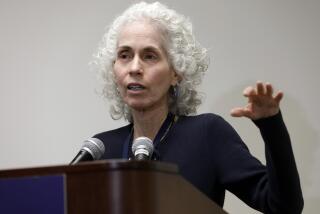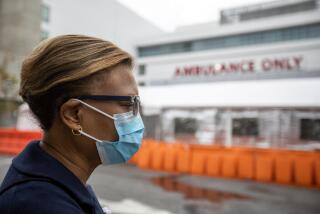Study Sees Shift in ER Care
- Share via
The number of uninsured patients visiting private emergency rooms jumped by a third in the last five years as overcrowded public hospitals turned away patients, according to a newly released study.
The report is the first to quantify how many uninsured patients have turned to private hospitals, a trend that hospital officials say is largely responsible for the closure of nine hospitals and emergency rooms across Los Angeles County in the last few years.
Hospitals are required by law to treat all patients who come into their emergency rooms.
As public hospitals became more overburdened, visits by the uninsured to the county’s four public emergency rooms declined 27% from 2000 to 2005, according to the study, conducted for the Hospital Assn. of Southern California using state data and reports from individual hospitals.
The numbers, which analysts at the National Health Foundation crunched for the association, suggest that many of the former county patients are now going to private emergency rooms, leaving those hospitals to pick up the costs.
About 2.25 million residents lack health insurance in the county, which has one of the highest percentages of such people of any major U.S. metropolitan region.
Because government programs provide insurance for many children in low-income families and for people who have reached retirement age, most of the uninsured are 19 to 64 years old.
The vast majority are working, but at jobs that lack health benefits. Illegal immigrants compose up to 20% of the uninsured population, according to estimates by researchers at UCLA, but the bulk are citizens.
County officials acknowledged Thursday that they had reduced the number of beds available in their emergency rooms because of budget shortfalls and difficulty finding enough medical professionals. The county Department of Health Services has also closed 15 community clinics since 2002 and reduced the number of transfers it accepts to its hospitals, because they are already overtaxed.
“Is it true there is more of a burden on private hospitals over time? I think that certainly is a reasonable inference from this,” said Dr. Jonathan Fielding, who heads the county’s public health agency.
But he said the problems at county hospitals were only one factor in the rise, arguing that there were also simply more people without insurance now.
Administrators at private hospitals say that they are losing millions of dollars from ER visits not covered by insurance and that these losses have contributed to the closure of some facilities.
One of the hardest hit is Downey Regional Medical Center.
Several county clinics that shut down in 2002 were located in a ring around the city of Downey.
In the year after the closures, the total number of the hospital’s emergency room patients, insured and uninsured, jumped to 50,000 from 40,000, said Chief Operating Officer Rob Fuller.
Additionally, the uninsured patients seem to be waiting longer before seeking treatment, so they often arrive needing more extensive and expensive care.
In 2002, the hospital lost more than $1 million caring for uninsured patients in the emergency room. By 2004, that figure had ballooned to about $6 million, Fuller said.
“We need to find a way to compensate private hospitals for providing such massive amounts of care for the uninsured,” he added, echoing the views of other administrators. “Or frankly, we’re going to see a lot more hospitals go out of business. We’ve been forced to use our trust funds for what we think of as a private tax.”
Although Downey is considered an extreme case, other ERs are also feeling the pinch.
At California Hospital Medical Center in downtown Los Angeles, spokeswoman Katreena Salgado said her emergency room had seen the number of uninsured patients double in the last two years.
“We take our responsibility for the uninsured seriously,” she said. “But a lot of the losses we’re experiencing can be attributed to this issue.”
At Cedars-Sinai Medical Center on the Westside, officials said they were also dealing with more uninsured patients but could not provide exact numbers.
The new study comes as healthcare costs have emerged as a major political issue in California.
Hospitals, with the aid of Gov. Arnold Schwarzenegger, have been trying to delay implementation of the state’s strict nurse-to-patient ratios.
Hospitals say they cannot afford to hire more nurses (although California Nurses Assn., which pushed for the ratios, said they are needed to ensure patient safety).
The state Legislature is also considering three bills addressing the way hospitals treat patients who can’t pay their bills. Among other things, the measures would restrict how hospitals collected bills from these patients and would require the hospitals to absorb a certain percentage of the losses for patients who couldn’t pay the full amount owed.
Jim Lott, spokesman for the Hospital Assn. of Southern California, said the study’s findings showed that hospitals were already overburdened.
He estimated that, at the 40 private hospitals reporting jumps in emergency room visits by the uninsured, the cost of caring for them rose from $63 million in 2000 to $77.5 million in 2004.
“Maybe 10% to 15% of that cost would be paid by patients,” Lott said. “So we’re talking 85% to 90% actual losses to the hospital.”
But Lark Galloway-Gilliam, executive director of Community Health Councils, a Los Angeles-based nonprofit organization, said the study was not as conclusive as the hospital industry might suggest.
Many uninsured patients end up getting charged full price for their procedures and many end up with bill collectors pursuing them for those charges, she said.
She added that some of those patients ended up paying at least a portion of the bills.
Galloway-Gilliam said she feared that the shift to private emergency rooms would leave patients with heavy debts that could bankrupt them.
More to Read
Sign up for Essential California
The most important California stories and recommendations in your inbox every morning.
You may occasionally receive promotional content from the Los Angeles Times.










